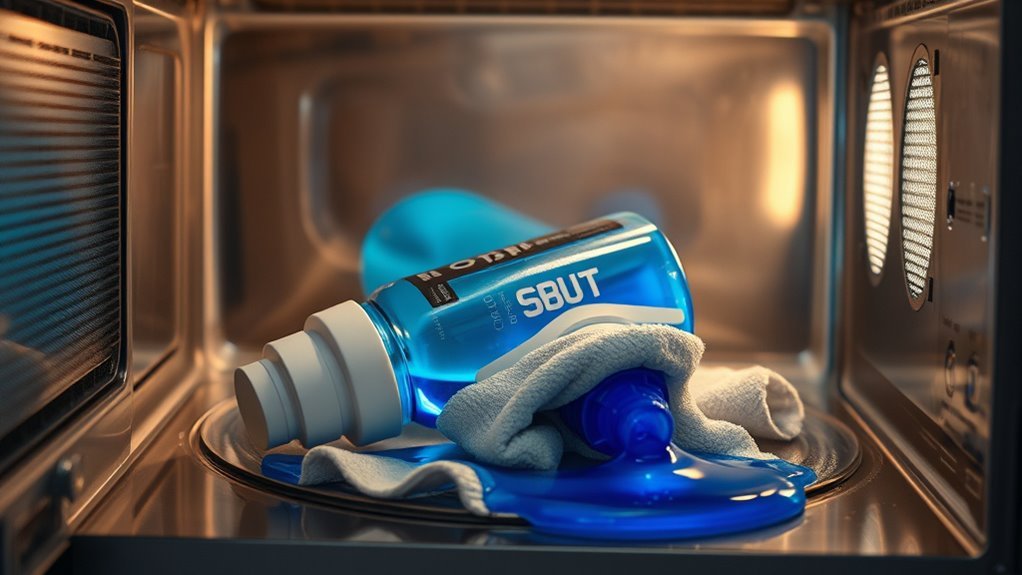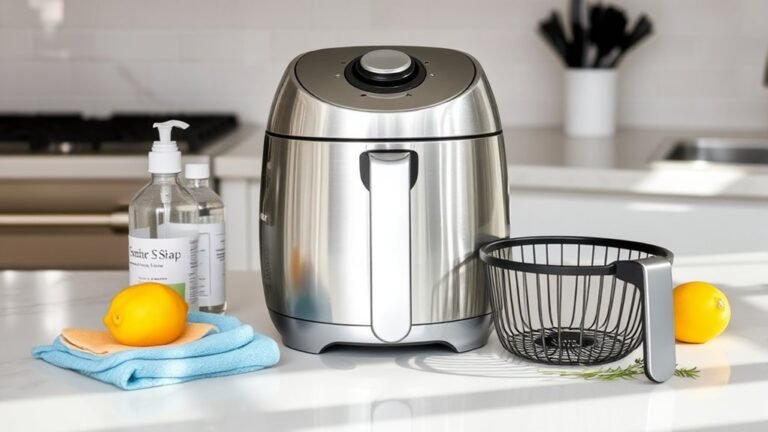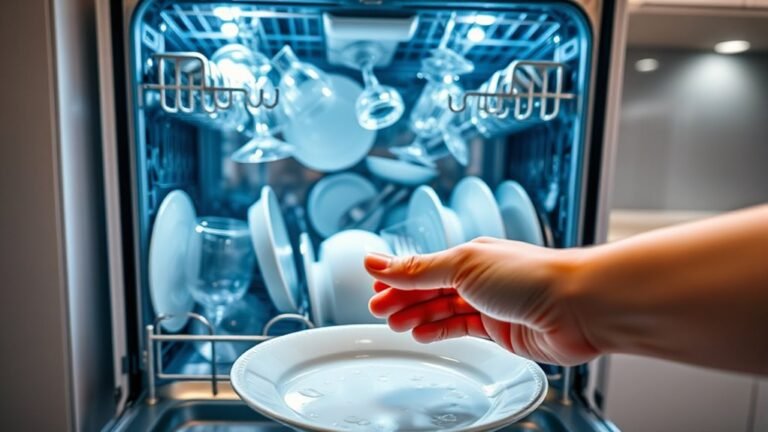Common Mistakes When Cleaning Microwave
When cleaning your microwave, avoid harsh chemicals and abrasive tools that can damage surfaces. Always unplug it first to prevent electrical hazards. Don’t neglect the turntable, roller ring, and ventilation areas, as buildup there affects performance and safety. Regular cleaning is vital to prevent odors and maintain efficiency. Skipping these steps shortens your microwave’s lifespan. If you want to master effective and safe cleaning methods, keep exploring these essential guidelines.
Using Harsh Chemicals That Damage Surfaces

Although it might seem effective, using harsh chemicals to clean your microwave can actually damage its surfaces. These substances, often acidic or abrasive, can degrade the interior coating, leading to surface damage that compromises the microwave’s efficiency and longevity. You want to avoid corrosion or discoloration caused by strong chemical agents. Instead, opt for mild, non-abrasive cleaners designed specifically for microwave use. This approach preserves the integrity of the surfaces while ensuring effective cleaning. Remember, maintaining your microwave’s surface is essential to its proper function and your freedom from frequent repairs or replacements. By steering clear of harsh chemicals, you protect both the appliance and your ability to clean it safely and confidently. Prioritize gentle methods to avoid irreversible surface damage.
Ignoring the Microwave Turntable and Roller Ring
A common oversight in microwave maintenance is neglecting the turntable and roller ring. These components guarantee even heating by rotating food, but they often accumulate food debris and spills that impair functionality. For effective turntable maintenance, remove both the glass plate and roller ring regularly, then wash them with warm, soapy water. Avoid abrasive cleaners that can damage surfaces. After drying, inspect the roller ring for cracks or warping, as a compromised roller ring can cause uneven rotation or noise. Proper care prevents wobbling and extends your microwave’s lifespan. By routinely cleaning and inspecting these parts, you maintain ideal performance and avoid the inconvenience of unevenly heated meals. Don’t overlook this step if you want your microwave to work efficiently and reliably every time.
Cleaning Without Unplugging the Microwave

You shouldn’t clean your microwave without unplugging it first because it poses a serious safety hazard, including the risk of electric shock. Additionally, moisture can damage the appliance’s electrical components if it’s still powered during cleaning. Always disconnect the microwave to protect both yourself and the device.
Safety Hazards Risk
How safe is it to clean your microwave without unplugging it first? It’s a common oversight, but neglecting this safety precaution exposes you to serious microwave hazards. Even when the microwave appears off, residual electrical current can pose shock risks during cleaning, especially if moisture contacts internal components. You want to avoid accidental activation, which could cause burns or injury. Taking proper safety precautions means unplugging the appliance before you start cleaning—this simple step eliminates electrical risks and guarantees your freedom to clean thoroughly and confidently. By respecting these guidelines, you protect yourself from harm while maintaining your microwave’s integrity. Don’t skip this critical step; it’s essential for safe, effective cleaning without unnecessary danger.
Appliance Damage Potential
While it might seem convenient to clean your microwave without unplugging it, doing so can cause significant damage to the appliance’s internal components. Electrical currents remain active, increasing the risk of short circuits or component failure if moisture seeps inside. This exposure can drastically reduce the appliance lifespan, forcing premature replacements. Additionally, accidental activation during cleaning could damage sensitive electronics, leading to costly repairs. By unplugging, you eliminate these risks, preserving your microwave’s functionality and minimizing repair costs. Prioritize disconnecting power before cleaning to maintain peak performance and extend the appliance’s service life. This simple step safeguards your freedom from unexpected breakdowns and expensive fixes, ensuring your microwave remains reliable for years to come.
Overlooking the Exterior and Ventilation Areas
Although many focus solely on the microwave’s interior, neglecting the exterior surfaces and ventilation areas can compromise its performance and safety. Skipping exterior cleaning allows grease and dust to accumulate, which not only looks unsightly but can also lead to overheating. You should wipe down the microwave’s outer shell regularly with a mild detergent to prevent dirt buildup. Ventilation maintenance is equally critical; blocked vents restrict airflow, causing the microwave to overheat and potentially shorten its lifespan. Use a soft brush or vacuum to clear dust from vents without damaging components. By incorporating thorough exterior cleaning and consistent ventilation maintenance into your routine, you guarantee your microwave operates efficiently and safely, giving you the freedom to enjoy hassle-free cooking without unexpected breakdowns.
Scrubbing With Abrasive Materials

If you want to preserve your microwave’s surfaces, you shouldn’t use abrasive materials for scrubbing. Abrasive tools, such as steel wool or harsh scouring pads, can scratch and damage the interior coating and exterior finish. These microscopic scratches compromise the protective layer, leading to corrosion and reduced microwave efficiency. Instead, opt for non-abrasive cleaning techniques like using a soft sponge or microfiber cloth with mild detergent. This approach removes grime effectively without harming surfaces. Avoid excessive force during cleaning to maintain the integrity of the microwave’s materials. By selecting appropriate cleaning tools and methods, you maintain the appliance’s longevity and guarantee safe operation. Freedom in your kitchen comes from understanding these precise techniques, enabling you to clean efficiently without risking damage.
Neglecting Regular Cleaning Schedules
You can’t afford to skip regular microwave cleanings, as buildup worsens over time and affects performance. Inconsistent cleaning leads to stubborn stains and potential odors that become harder to remove. Establish a routine using simple, quick methods to maintain efficiency and hygiene consistently.
Importance of Consistency
Regularly cleaning your microwave is essential to maintain its efficiency and hygiene. Sticking to a consistent cleaning frequency prevents buildup of food residues and bacteria, ensuring peak performance. By establishing a cleaning routine, you minimize the risk of odors and stains, which can degrade the appliance over time. Consistency in maintenance not only extends your microwave’s lifespan but also frees you from the hassle of deep cleaning sessions. The routine benefits include saving time and effort while preserving your microwave’s appearance and function. Adopting a disciplined cleaning schedule empowers you to enjoy a reliable appliance without interruptions. Don’t let irregular habits compromise your freedom; instead, make consistency a priority for a cleaner, more efficient microwave every day.
Effects of Irregular Cleaning
When cleaning schedules are neglected, residues and spills accumulate quickly, leading to decreased microwave efficiency and potential hygiene issues. Irregular cleaning compromises microwave hygiene, allowing bacteria and odors to develop. You’ll notice longer cooking times as microwave energy gets absorbed by food debris rather than heating your meals efficiently. Furthermore, stubborn stains become harder to remove, requiring more aggressive methods that might damage the interior surface.
- Increased risk of bacterial growth due to food residue buildup
- Reduced microwave power output and uneven heating
- Persistent odors affecting food taste and safety
- Accelerated wear on mechanical components from grime interference
Tips for Routine Maintenance
Although neglecting routine cleaning can seem harmless, establishing a consistent maintenance schedule is crucial to preserve your microwave’s performance and hygiene. You should perform a routine inspection at least once a week to identify food residue or damage early. Using appropriate cleaning tools, such as non-abrasive sponges and microwave-safe cleaning solutions, guarantees thorough cleaning without harming the appliance. Avoid harsh chemicals or metal scrubbers that can damage the interior. Set reminders to clean both the inside and outside surfaces regularly, including the door seals and ventilation areas. This proactive approach prevents buildup that could impair efficiency or cause odors. By integrating these practical steps into your cleaning routine, you maintain your microwave’s reliability and extend its lifespan without sacrificing your time or freedom.
Frequently Asked Questions
Can I Use Vinegar to Deodorize My Microwave?
Why settle for harsh chemicals when you can use vinegar benefits for deodorizing methods? You can definitely use vinegar to deodorize your microwave. Its acetic acid neutralizes odors and breaks down grime effectively. Simply mix equal parts vinegar and water, heat it inside the microwave until it steams, then wipe clean. This practical approach frees you from synthetic scents, offering a natural, efficient solution to keep your microwave fresh.
Is It Safe to Microwave Lemon Water for Cleaning?
Yes, it’s safe to microwave lemon water as a cleaning solution. When you heat lemon juice mixed with water, the steam softens grime inside your microwave, making it easier to wipe away. Just place the mixture in a microwave-safe bowl, heat it for a few minutes until it steams, then let it sit briefly. The natural acidity of lemon juice helps deodorize and clean effectively without harsh chemicals, giving you a fresh, effortless clean.
How Often Should I Replace My Microwave’S Charcoal Filter?
You should follow the manufacturer’s guidelines for charcoal filter maintenance to guarantee peak performance. Typically, the filter replacement frequency ranges from every 6 to 12 months, depending on microwave usage and ventilation conditions. If you notice reduced odor absorption or increased cooking smells, it’s time to replace the filter. Regularly monitoring your charcoal filter helps maintain air quality and extends your microwave’s efficiency, giving you freedom from lingering odors.
Can Food Stains Cause Microwave Sparks or Fires?
Yes, food stains can contribute to microwave sparks or fires if not cleaned properly. When food particles accumulate, they create hotspots that disrupt microwave safety by causing uneven heating or arcing. These hotspots can ignite or damage the interior. To maintain safe operation and your freedom to use your microwave without worry, regularly clean any food residues inside the cavity, ensuring the appliance functions efficiently and reduces fire risks.
What Is the Best Way to Remove Microwave Odors Naturally?
Want to banish those stubborn microwave odors naturally? You’ll want to mix baking soda with a few drops of your favorite essential oils, like lemon or eucalyptus. This combo acts as a powerful deodorizer, absorbing smells without harsh chemicals. Simply place the mixture in an open bowl inside the microwave, run it for a minute or two, then wipe clean. This practical method gives you fresh air and freedom from artificial scents.






